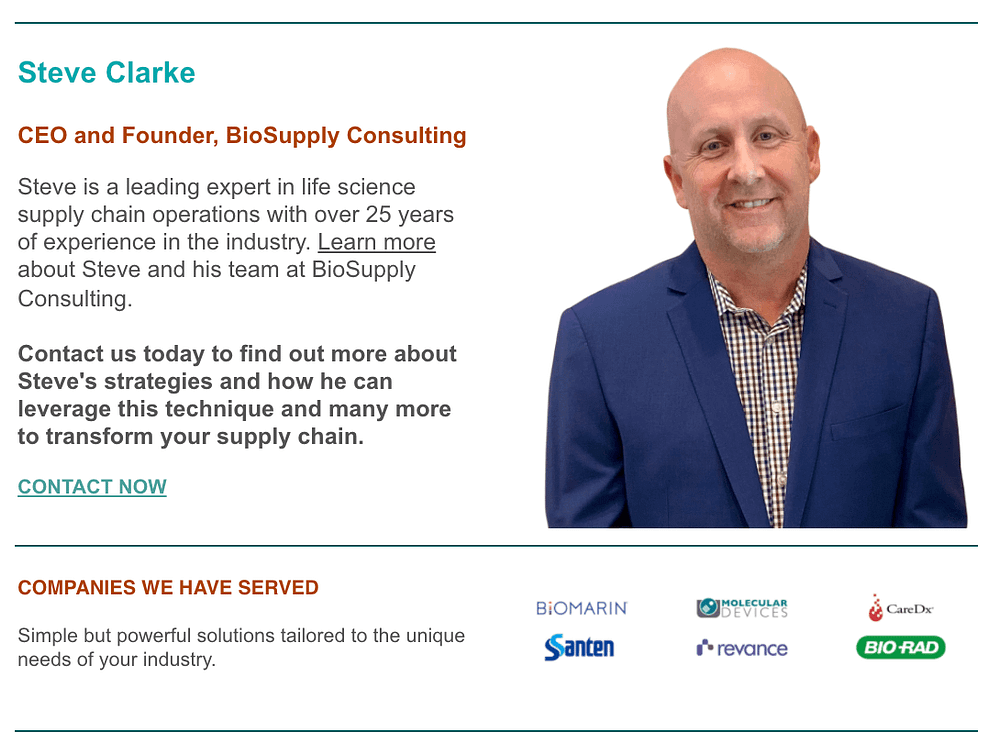LIFE SCIENCE SUPPLY CHAIN SOLUTIONS BY STEVE CLARKE
Challenge
A current BioSupply life science client has pallets of inventory in their offices, in the lunchroom, on trailers, in the aisles, under employee desks, etc. Even worse, in their ERP system, inventory just shows as ‘in the warehouse”, with no bin location, which makes it really difficult to find specific items. The situation is that bad, that they need to remove about 30 pallets of materials every day and put them outside, just so that they can perform regular operations. Then at the end of the day, they must all be brought back in again. They perform cycle counts and although they haven’t measured inventory record accuracy yet, they know it is low, which just makes the situation worse. Planners and Buyers often feel the need to find the items in the warehouse themselves, rather than rely upon the ERP system. With the challenges that COVID has created in the supply chain, these inventory issues are even more disruptive since it can take so much longer to react. All of these result in line-down events, late customer orders, and revenue risk. In addition, they are expected to grow their inventory by 50% this year to keep up with anticipated sales growth, and extra safety stock to reduce future supply risk.
Solution
The typical approach to overflowing inventory is to open the wallet to solve the problem, right? Indeed that has been the client’s approach so far. Firstly, they purchased a carousel to store smaller parts, which I assume was very expensive. In addition, they have been seeking offsite storage space and they have leased 6 trailers. This may be necessary, but I have an issue with using this approach until they have made the most of the space that they currently have. It should be the last resort, not the first resort.The first resort should be to hold a kaizen event (workshop) to address the current situation. This is where we are today, a kaizen event will be held in a few weeks, and I will report the progress that we have made over the next few newsletters. Employees of the client are highly skeptical, so it will be interesting to see whether we hit our goals (see Results section) At this point, we are performing pre-kaizen activities, which primarily entails collecting the following data:
- Excess inventory by commodity type. Before we can measure this, the definition of excess inventory must be developed. In this case, we have defined it as any time that has not been used in the past 6 months, does not have future MRP demand, and is not required by field service for spare parts.
- Historical cycle count data to measure accuracy.
- Take a sample of cycle count errors over the past few weeks and attempt to determine the cause of the inaccuracies. This will help prioritize our activities during the kaizen event.
- Estimate how much cubic space each commodity consumes in the warehouse, to help prioritize which commodities to improve inventory planning during the kaizen event.
- Define new warehouse layout to minimize wasted aisle space and maximize vertical space.
- Measure current inventory by cubic space requirements by item (Full pallet, ½ pallet, ¼ pallet, Bin/Box).
- Measure current warehouse layout profile by cubic space (Full pallet, ½ pallet, ¼ pallet, Bin/Box) to see if it is aligned with actual inventory requirements
Testimonial
“Master at running Kaizen events using the DMAIC process”
– Michael Slauson, Senior Global Commodity Specialist
Results
The Kaizen will start in a few weeks, so we do not have many results yet. However, we do have some results from the initial pre-kaizen activities:
- Cycle count accuracy over the past 6 months has been about 66%. In a manufacturing environment, this should be around 95%, so lots of room for improvement.
- The number of items that are considered to be excess and obsolete, is around 33% of the total number of items. While it may not be advisable to scrap all these items yet, they can be consolidated into multi-item containers, which will significantly reduce space requirements.
- The stretch targets have been set as follows:
- Increase warehouse storage capacity by 50%
- Improve cycle count accuracy to >95%
- Eliminate non-warehouse storage
As mentioned, I look forward to continuing to report our progress in future newsletters. Stay tuned!


